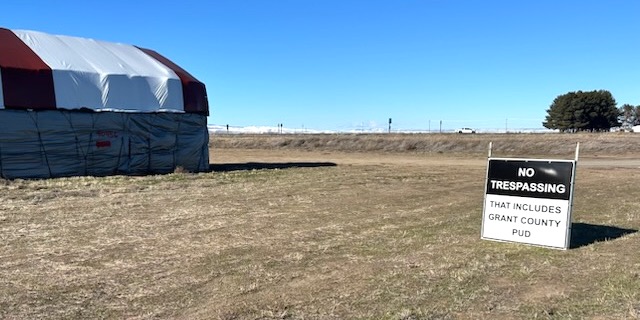ONLINE Dan Fulleton Farm Equipment Retirement Auction
THIS WILL BE AN ONLINE AUCTION Visit bakerauction.com for full sale list and information Auction Soft Close: Mon., March 3rd, 2025 @ 12:00pm MT Location: 3550 Fulleton Rd. Vale, OR […]
Published 8:10 am Monday, February 3, 2025

Grant County, Wash., farmers opposed to having a major transmission line on their property have a problem: It’s easier for the local utility to condemn private land than cut through the red tape to build the new line on public land.
The farmers and other landowners have been trying unsuccessfully for two years to persuade Grant County Public Utility District to reconsider its route for a 230-kilovolt transmission line between Wanapum Dam and Quincy, a data center hub in Central Washington.
The 31-mile, $40 million line will impact 34 homes and 449 acres zoned for agriculture. The PUD considered other routes, including two shorter routes that would have affected eight or nine homes, half as many agricultural acres, and cost about $7 million less to build.
The two routes, however, cross a wildlife area managed by the Washington Department of Fish and Wildlife. Fish and Wildlife was open to letting the line through, but warned it could take several years to get the proposal through the bureaucracy.
“We determined that the permitting process over large expanses of public lands, some of which are protected habitat, was time-consuming enough to be prohibitive, given the urgent, public need for more transmission capacity to meet current and future demand in the Quincy area as our county grows,” PUD spokeswoman Christine Pratt said in an email.
Measured by people, Quincy, population 8,542, has grown 6% in the past five years. But Microsoft and other large companies have data centers there. Farmer John Rylaarsdam said he doesn’t resent the demand for electricity, but he wishes more consideration was given to private property when routing new transmission lines.
“It’s easier to condemn private ground than it is to work with public entities, and that is the core of our frustration,” said Rylaarsdam, whose operations will be impacted by the transmission line.
Grant County produced $2.6 billion worth of farm goods in 2022, according to the USDA Census of Agriculture. It ranked No. 1 among Washington’s 39 counties and No. 10 among all U.S. counties.
All routes considered by the PUD crossed farmland, but the two with least impact to agriculture were the ones that would have have crossed the Quincy Lakes wildlife area.
High-voltage transmission lines, built in the 1960s about the time Fish and Wildlife bought the land for wildfowl habitat, already cross the wildlife area. New lines could be added in the same path.
“We are fine with new lines coming through,” Fish and Wildlife spokeswoman Staci Lehman said. “We did let the PUD know that.”
At a meeting in 2022, Fish and Wildlife officials warned getting a new line through could take several years, according to notes from the meeting.
The Fish and Wildlife Commission, governor, state attorney general and federal government, which funds the department’s land acquisitions, might all have to give approval, officials said.
Plus, the PUD might have to buy land or make a payment to offset crossing the wildlife area. Because the federal government would be involved, the project might have to undergo review under the National Environmental Policy Act.
Fish and Wildlife’s time frame didn’t match the PUD’s. The utility was ready to get on with selecting a route.
The bureaucracy hasn’t adjusted to the state’s quest to make and move green energy, leaving it to private owners to make accommodations, said Lisa Marcusen, whose family started farming in the area in the 1950s.
“We need to get rid of these old antiquated rules,” she said. “This fight isn’t just about us. Every private property owner in Grant County needs to be worried and aware this can be forced upon them.”
Opposition to the route didn’t begin until it was selected. Farmer John Eiler said he learned from a letter in the mail that his farm was on the route. “That was the first we heard about it,” he said.
The PUD says it alerted the public to potential routes. It held one open house attended by 11 people. A second open house was attended by five. The PUD assumed there was no opposition to the route, according to recordings of PUD commissioner meetings.
Farmers have attended several meetings by now, making their complaints known. The PUD was presented with a petition, signed by 145 people, opposing the route.
The farmers have not made any headway. “It’s a rough and rocky road,” Rylaarsdam said.
The line will mostly parallel a road, but the poles will be set back on private property. Farmers said they are concerned the line will interfere with irrigating crops, stacking hay, aerial spraying, and adding or expanding buildings.
Lining the road are signs that say, “Stop the PUD Land Grab” and “No Trespassing: That Includes Grant County PUD.”
Pratt, the PUD spokeswoman, said the utility will offer a fair market price for the private land.
“We consider condemnation a remedy of last resort, but unfortunately necessary at times for the greater public benefit and the future of our capacity to supply Grant County customers with electricity,” she said.
The PUD expects to begin construction in 2027 and energize the line by late 2028. “Grant PUD will build the 31-mile, 230KV Wanapum-to-Mountain View Transmission line along the selected route,” Pratt said.
Rylaarsdam said he understands growth is important. “But we wish there was more thought about the impact to the people who have been here,” he said.